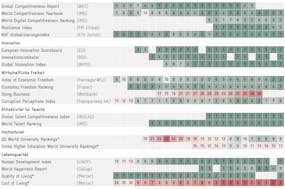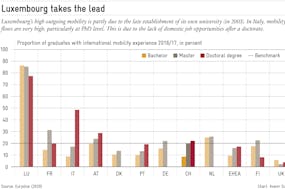Artificial intelligence (AI) has the potential to transform the world of work. Case studies show that AI applications, including the latest large-scale language models, can significantly increase productivity in professions such as customer service and management consulting. Swiss companies also seem to share this view. Investments in IT, communication and technology already account for 30 percent of all equipment investments by Swiss companies – more than during the dotcom bubble.
Two dimensions of AI
It is still unclear whether the productivity gains observed in the case studies can be transferred to other areas. The examples given may be limited to activities that are relatively easy for AI to take over. In order to make statements about other occupational groups, economists have now developed models that allow for a systematic analysis. Although no method can reliably predict the impact of AI and all its feedback effects on the world of work,, the models at least provide a snapshot of the far-reaching effects.
In the first step of our analysis, we identify the basic skills that are required to perform common jobs today. What does a call center agent need to know, what does a dentist need to know? In a second step, we can estimate the extent to which these skills sets are at risk of substitution or whether they are more likely to be complemented by AI applications.
We use this approach to measure the impact of AI applications on the occupations performed by the Swiss workforce. We distinguish between two dimensions, which are explained in more detail in the box at the end of the article:
- Affectedness: How strongly is a profession potentially affected by AI, i.e. how extensively are the skills required for it affected by AI? The higher the corresponding Exposure Score, the greater the proven impact of AI on the occupation in question. However, the indicator does not differentiate by the mode of action of the AI: it is not possible to say on the basis of this measure whether individual AI applications tend to replace or complement the skills of the professional. For such an assessment, the second dimension of complementarity must be used.
- Complementarity: Are the effects of AI likely to be substitutive or complementary, i.e. are workers in an occupation more likely to be supported by AI in the content of their work or to be in competition with it? The higher the complementarity score, the more likely it is that AI could have a supportive effect on the occupation.
Benefiting, favored and less affected occupations
Based on the exposure and complementarity scores, four “AI quadrants” can be formed in which the occupations – or occupational clusters – can be located:
- Benefiting occupations (1st quadrant): Judges and lawyers have above-average exposure and complementarity scores. AI applications increasingly cover the skills of the workforce, while at the same time the technology has a complementary effect due to the content of the work. Employees in this quadrant benefit from productivity gains.
- Favored occupations (2nd quadrant): Police officers have a below-average exposure score, so their skills are less affected by AI. At the same time, their complementarity score is above average, meaning that AI can have a positive impact on their work.
- Less affected occupations (3rd quadrant): Hairdressers are relatively unaffected by AI. They have below-average exposure and complementarity scores. As a result, they are not in direct competition with AI, but are also unable to use it to their own advantage.
- Vulnerable occupations (4th quadrant): Call center agents are more likely to be affected by AI applications in terms of their skills, but can only derive limited benefit from AI in their work. It is conceivable that AI will compete directly with employees in this group.

The figure shows that managers and teachers benefit from advances of AI just as much as natural scientists, social scientists and legal scholars. For employees with an academic background, however, the transition from a productivity-enhancing, complementary use of AI to a competitive relationship is fluid. Business economists and communications specialists, for example, are more likely to be among the group of professions at risk from AI. As a result, their work tends to consist of tasks that could be delegated to AI.
The groups of “less exposed” and “beneficiaries” – and thus the group of professions with an exposure score below the median value – are very heterogeneous. They include electricians and security staff as well as engineers and academic healthcare professionals (pharmacists, doctors). This occupational group in particular has one of the highest complementarity scores, but is exactly average for all occupations in terms of exposure.
Looking at other major occupational groups, it is noticeable that unskilled workers and low-skilled workers are likely to benefit comparatively little from the opportunities (and risks) of AI. The winners are managers (90% of whom are in the first quadrant), while on the other hand 80% of office workers are potentially at risk of from AI competition. In absolute terms, this means that a total of 490,000 office workers could find themselves in direct competition with AI. This is especially true for office workers without specialization. That is about 380,000 employees.

After this tour d’horizon, in the second part of the blog we will look at the influence of education, gender or age of a worker on whether AI acts as support or new competition. Finally, we turn to the role of the state in this aspect of structural change on the labor market.
Methodology
Measuring exposure
To measure exposure, we draw on the assessments of a group of US economists from Princeton University and New York University(Felten et al., 2021). The starting point of their work is the understanding that a certain set of skills is required to perform a job, i.e. a mix of cognitive, manual and social skills. The next step is to assess the extent to which AI applications are currently able to cover these skills. For example, it is determined whether AI applications in the field of image recognition can cover human skills for near and far distance vision. The sum of the assessed skills results in the job-specific exposure score.
Measuring complementarity
To measure complementarity, the job-specific work context is taken into account (Pizzinelli et al., 2023). The work context refers to the physical and social conditions in which a profession is performed. These determine whether AI requires human supervision. If the AI needs to be supervised, it can only have a complementary effect. This will be the case, for example, if wrong decisions have major consequences that could endanger the health and safety of other people, or if the profession requires personal interaction. Even if such sensitive decisions are not (yet) fully delegated to AI, the technology can still support the human decision-maker, for example by providing additional information to avoid mistakes or by pointing out alternative decision-making options. If a profession is strongly characterized by these work contents, it is assumed that AI has a complementary rather than a substitutive effect on the profession.. Complementarity is largely independent of the extent to which the occupation is exposed to developments in AI technology.
Felten et al. (2021) and Pizzinelli et al. (2023) use the O*NET database maintained by the US Department of Labor to determine their scores. This is often used in labor economics to measure the occupational content of jobs or tasks.






